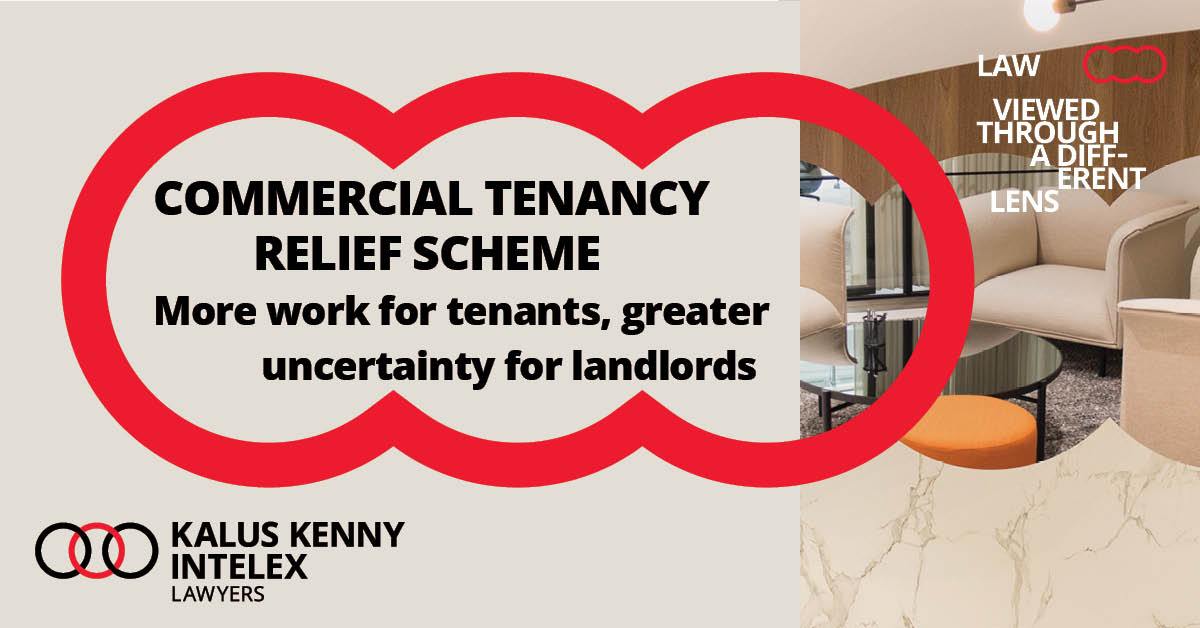The Commercial Tenancy Relief Scheme Regulations 2021 operates from 28 July 2021 until 15 January 2022.
The State Government rent relief scheme is more complicated than the previous Jobkeeper-based scheme. The scheme introduces stricter compliance for tenants with mandatory timelines that will raise the bar for entry. For landlords, a range of new tests for eligibility and turnover complicate a landlord’s proper assessment of eligibility and what relief should be offered.
What are the key changes?
The test for eligibility is again based on a decline in turnover. Once eligibility has been established, the requirement that an offer be made by the landlord constituting rent waiver, deferred rent and an extension of lease term, largely follows the previous scheme.
This time however, there are a range of tests that account for a variety of tenant circumstances, including a new test for businesses that only started operating after 1 April 2021.
The alternative tests accommodate:
- sole traders or small partnerships experiencing sickness or illness
- businesses that temporarily ceased trading during a relevant period
- businesses with irregular turnovers
- businesses that have restructured or have had a change in ownership
Otherwise, the primary test for businesses that were operating before 1 April 2021:
- compares the relevant turnover test period which is (at the tenant’s election), a consecutive 3 month period between 1 April 2021 and 30 September 2021 (inclusive), commencing on the first day of a month;
- to the relevant comparison period which is the 3 month period in 2019 corresponding to the 3 month period chosen by the tenant as their turnover test period.
There needs to be a 30% reduction in turnover between these periods for the tenant to be eligible for relief.
Turnover includes internet sales of goods and services and State Government business grants received during the turnover period, but excludes any Federal Government assistance.
The Tenant is eligible for relief. What happens next?
Once a tenant is eligible, it must make a valid request under regulation 27(1) and 27(2).
A request to the landlord must be in writing and include a statement
- that the tenant is an eligible tenant;
- that the tenant satisfies the decline in turnover test;
- nominating the relevant turnover test and period used;
- advising as to the comparison turnover test and period used, or if an alternative was used, and if an alternative test was used, how it was calculated;
- specifying the relevant decline in turnover;
- specifying the reduction in rent that would satisfy the minimum requirements of a landlord’s offer under subregulation 8; and
- informing the landlord of any other circumstances that the tenant would like the landlord to consider when making its rent relief offer.
But that’s not all. The tenant has to then follow its request by providing supporting information and a statutory declaration.
What exactly does need to be disclosed?
Within 14 days of making the request, the tenant has to provide information to the landlord that evidences the turnover figures contained in the tenant’s request, including information that is in the form of at least one of the following:
- an extract from the tenant’s accounting records;
- the tenant’s business activity statements;
- a statements from the tenant’s bank in respect of the tenant’s account; or
- a statement from the tenant’s practising accountant.
AND
The tenant must also supply a statutory declaration made by the tenant or an authorised officer of the tenant, stating it is an eligible tenant and that the information provided by the tenant is true and to the best of the tenant’s knowledge and belief.
If the tenant doesn’t comply with this part within 14 days, the request lapses. The tenant may then make a new request for rent relief but after 3 lapsed requests, they can’t make more.
What does the landlord have to do once it receives a formal request?
The landlord has to reply with an offer for rent relief within 14 days after receiving the final information from the tenant, unless otherwise agreed in writing.
The landlord’s written offer for rent relief must:
- relate to up to 100% of the rent payable during the rent relief period; and
- at a minimum be proportional to the tenant’s decline in turnover;
- include no less than 50% of the rent relief in the form of a waiver, unless otherwise agreed;
- also take into account any other circumstances the tenant asks the landlord to consider; and
- include outgoings, if the rent is ordinarily charged inclusive of outgoings.
Following receipt of the landlord’s offer, the tenant and landlord must negotiate in good faith with a view to agreeing on rent relief.
On the date that is 15 days after the tenant receives the landlord’s offer, there is deemed acceptance, unless:
- The parties reach an agreement, or
- The tenant has referred the matter to the Small Business Commission.
Mandatory reassessment of rent relief on 31 October 2021
The scheme includes a mandatory reassessment “checkpoint” that eligible tenants have to adhere to if:
- they have made a request for rent relief prior to 30 September 2021;
- the tenant’s business was in operation prior to 1 April 2021; and
- a rent relief agreement is in place (deemed or otherwise).
The mandatory reassessment requires a tenant to give to the landlord a further statutory declaration with updated turnover test period and updated comparison turnover information, and a percentage change in turnover to reassess any change in the tenant’s circumstances.
The updated period varies depending on when the tenant’s business commenced trading.
This declaration has to be given by 31 October 2021 and must again state that the tenant is an eligible tenant and that the information is true to the best of the tenant’s knowledge and belief.
Upon receiving the mandatory reassessment declaration, a landlord must respond within 14 days with an updated offer of rent relief.
Where to from here?
The complexity introduced by the State Government scheme, including tight timeframes and deeming provisions, makes it more important than ever to obtain appropriate and timely legal advice that takes into account the circumstances of each individual request for rent relief.
The summary above is provided for general information only.





